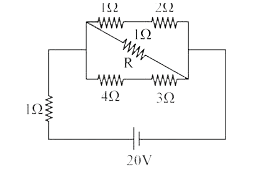Find voltage across resistor, and current through diode.

VD=0.7V
∴VR=8V−0.7V=7.3V
∴iR=iD=7.32.2×103=3.31×10−3A
Topper's Solved these Questions
- SEMICONDUCTOR ELECTRONICSBOOK - NARAYNACHAPTER - SEMICONDUCTOR ELECTRONICSEXERCISE - EVALUATE YOURSELF-1
5 Videos
- SEMICONDUCTOR ELECTRONICSBOOK - NARAYNACHAPTER - SEMICONDUCTOR ELECTRONICSEXERCISE - EVALUATE YOURSELF-2
3 Videos
- SEMI CONDUCTOR DEVICESBOOK - NARAYNACHAPTER - SEMI CONDUCTOR DEVICESEXERCISE - Level-II (H.W)
36 Videos
- WAVE OPTICSBOOK - NARAYNACHAPTER - WAVE OPTICSEXERCISE - Exercise - 4 Polarisation
9 Videos
Similar Questions
Knowledge Check
An a.c. voltage of peak value 20 V is connected in series with a silicon diode and a load resistance of 500 G. The forward resistance of the diode is 10 G and the barrier voltage is 0.7 V. Find the peak current through diode and the peak voltage across the load.
A37.8 mA, 18.9 VB5 mA, 30 VC30 mA, 5 VD2 mA, 2 VFind the current through resistor R.
 A9AB10AC11AD8A
A9AB10AC11AD8A
For the circuit shown in figure, find the voltage acrss 10Ω resistor and the current passing through it.

View SolutionFind the current through resistor R

View SolutionFrom the zener diode circuit shown in the figure, find (1) the output voltage (2) the voltage drop across series resistance and (3) the current through zener diode.

View SolutionAssuming that the silicon diode (having negligible resistance) the current through the diode is (knee voltage of silicon diode is 0.7V)

View SolutionA batery, with potential V across it, is connected to a combination of two idential resistors and them has current I through it. What are the potential difference acros and the current through either resistor if the resistors are (a) in series and (b) in parallel?
View SolutionFor the circuit shown in figure, Find
(1) the output voltage ,
(2) the voltage drop across series resistance ,
(3) the current through Zener diode.
 .
.
View Solution


